Wanted: guide to escape city centre chaos
In our current on-demand economy, we have become completely used to fast delivery. Ordered today, on the doorstep of your home, shop, or restaurant tomorrow . But nice mid-sized European cities are at risk of getting jammed by the explosive growth of traffic flows. Three UG researchers spoke with transport companies, entrepreneurs, and policymakers in Groningen, Mechelen, and Bremen. This resulted in six future scenarios and a firm warning: ‘The path to sustainable urban logistics is narrow. Without direction by the local government, it will not happen.’
Text: Riepko Buikema, Communication Office. Photos: Henk Veenstra
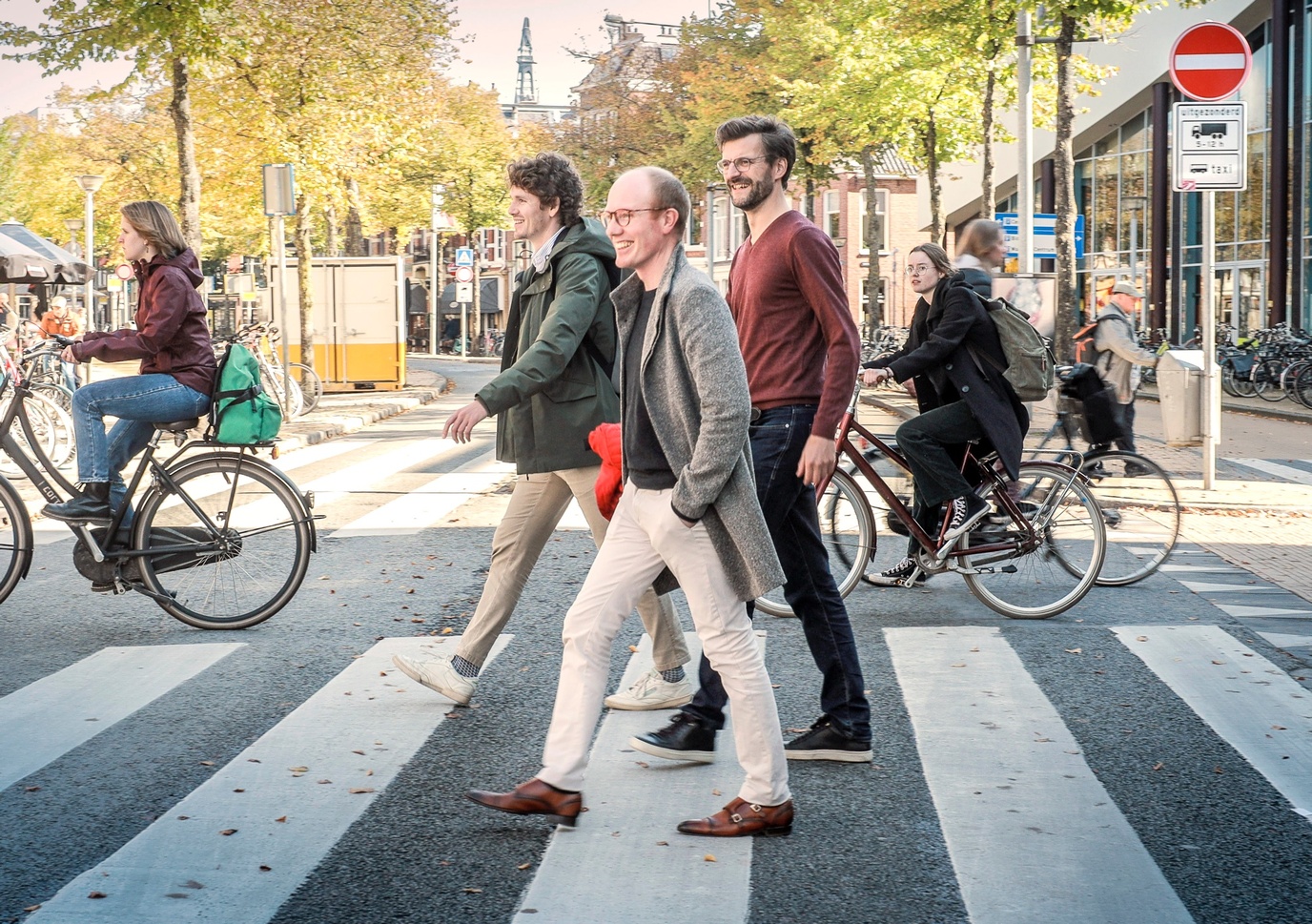
Making the rounds through the inner city of his beloved Groningen — to researcher of sustainable logistics Paul Buijs, this is pure enjoyment. ‘Traffic jams, trucks on the terrace, fast bike couriers crossing paths, ruthless takeout delivery drivers, construction and installation transporters, waste processors, large hospitality suppliers, small delivery drivers with their own specialties: cheeses, coffee, nuts. What a chaos. To me, that’s a party.’
A picture here, a video there. Great examples to use in the next lecture. ‘My area of expertise, logistics, determines more and more often how the city lives and breathes, what it looks like. A good example is the new package hub around the corner from the student flat here. Transport companies see it as an opportunity; for them it is very efficient. But you and I could also have our packages delivered there. That attracts traffic flows, with parked cars directly next to the turn into a narrow and busy cycling route. That package hub is located on private property, but does it fit into the streetscape? Is it safe?’
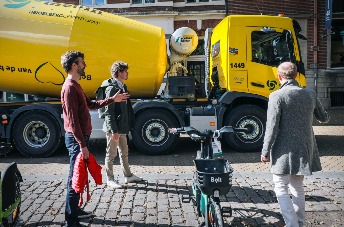
A way out of the jungle
We are all getting our packages, groceries, and meals delivered to our homes. The expectation is that the number of home deliveries will globally increase by 78% by 2030. ‘And that is only a section of the totality of logistical flows’, says Buijs. ‘Shop owners and other entrepreneurs in the inner city are also getting used to fast delivery. As a result, store supplies, hospitality deliveries, and construction logistics are gaining more impact on life in the inner city. This creates problems.’
Slowly but surely, historical inner cities are turning into crowded jungles filled with unsafe situations and air pollution. In the European study 'Urban Logistics as an on-Demand Service', Buijs explored a sustainable way out of this situation together with UG planners Ward Rauws and Paul Plazier. How could we transport goods into and out of the city in a cleaner and smarter way?
To find this out, the researchers took to the streets in Groningen, Mechelen, and Bremen, three mid-sized European cities with a historical centre. Plazier: ‘We talked extensively with the daily receivers and deliverers of packages and goods. DHL, UPS, Bpost, shop owners in the city, residents’ associations, municipal officials, public transport offices, local bike couriers. How do they envision the future?’
Ominous
The study resulted in six future scenarios, depending on the level of cooperation by transport companies and technological innovation, and the position taken by local governments. An ominous result: only two scenarios would lead to an inner city with sustainable logistics. In one future scenario ('New Cool Collective'), public and private actors would combine their powers to fundamentally reorganize logistical transport, delivery methods, and data management. In another ('Revolution by Design'), local governments would demand the development of sustainable logistical systems with a wide range of conditions and requirements.
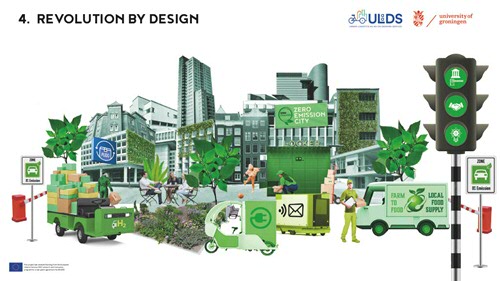
Incentives
‘The potential path to a sustainable future is narrow’, says Buijs. ‘It will be hard work to get there. There is quite a big chance that green policy will not take off or that market parties will not react in a desirable way. That we will end up in a situation in which residents complain and business owners are not able to receive their orders in time. These scenarios confront everyone with the facts. If we choose one of these scenarios, what will that mean? Because if we keep doing nothing, we are surely headed in the wrong direction. The non-bindingness of a distant future image needs to go. I hope that the images we have shown are incentives.’
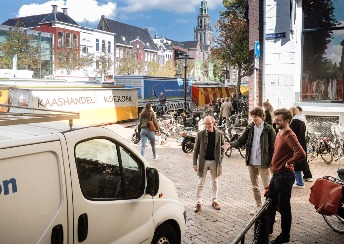
Not self-actualizing
The most striking finding of the international and interdisciplinary research collective? ‘The government is crucial in order to come to a sustainable solution. This poses a great challenge for policymakers at the municipal level’, says Plazier. ‘Transport companies are not suddenly going to get enthusiastic about sustainability themselves’, adds Buijs, ‘especially not without direction from governments. This might sound harsh, but it is true. In our 'New Wild West' scenario, for example, many aspects are changed, but the result is still undesirable because market parties target different solutions.’
Struggling
The local government as an irreplaceable guide to sustainable urban logistics. Municipalities have roughly two options, explain the researchers. Either demand greener and safer transport through a restrictive policy, or take the lead by setting up central communal hubs for goods and packages, for instance. But Plazier acknowledges that this is easier said than done.
‘The common idea is that municipalities do not have enough staff for a project this large. Well-meaning officials are responsible for everything from practical problems on the street and residents’ evenings to long-term policy. And that makes it really difficult. Our scenarios show that we need some tough thinking.’ Buijs: ‘I see municipalities struggling; take a look at the discussion surrounding fast bike couriers in the inner city. Do not forget that logistics has historically been left a hundred percent to the market.’
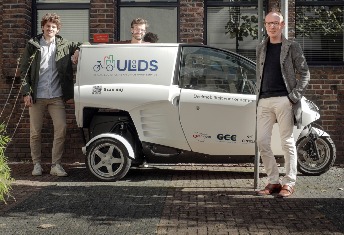
Groningen in front
There are also promising signals. At the initiative of the national government, 27 municipalities, like Groningen, decided to implement zero-emission zones. ‘A wonderful example of a local government taking charge, with a restrictive policy. This immediately leads to a shift in the market. Diesel vans are replaced by cargo bikes or small, electric vehicles. This also poses new questions: those clean transport methods might become bigger and heavier. Do we want that? How does this affect pedestrians in the inner city?’
Individual behaviour
We should also not forget the influence of consumers, emphasizes Plazier. ‘In a few scenarios, public opinion plays an important role. We can all have a lot of influence by holding transport companies responsible for sustainability and safety, or by picking up package at a central hub, for example. I myself used to blindly order anything and everything online. I don’t do this anymore. Thanks to this project, I have become a lot more conscious of this.’
More information
For further information about six future scenarios: What’s in store for last-mile logistics: Futures scenarios for last-mile logistics in mid-size European cities
| Last modified: | 01 February 2023 4.20 p.m. |
More news
-
01 April 2025
UGBS Executive MBA best-rated MBA | Dutch Master's Guide 2025
According to the independent Keuzegids Masters 2025, the Executive MBA of the University of Groningen Business School is the best rated MBA in the Netherlands (both part-time and full-time programmes).
-
01 April 2025
Executive Master of M&A and Valuation accredited as joint degree with Vrije Universiteit Amsterdam
Starting 1 September, participants enrolled in the programme will receive a master's degree from both the University of Groningen and Vrije Universiteit Amsterdam upon successful completion.
-
11 March 2025
East Groningen: universal basic services must be up to standard
Sjierdan Koster makes the case for long-term thinking and for bringing Groningen’s universal basic services up to standard.
